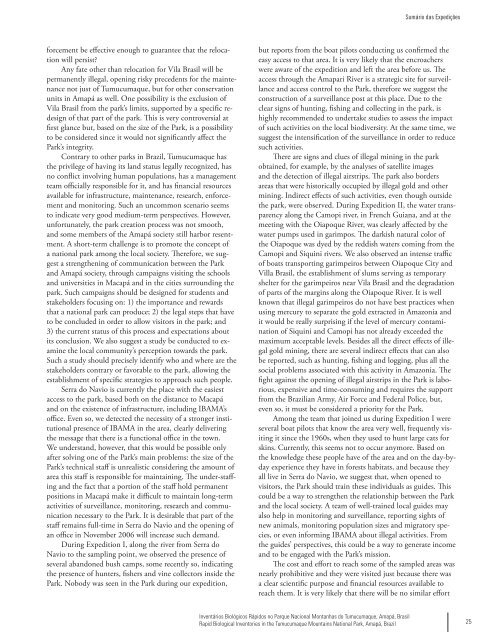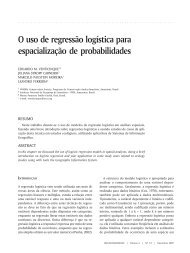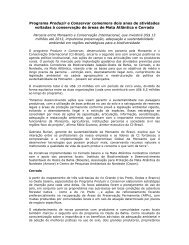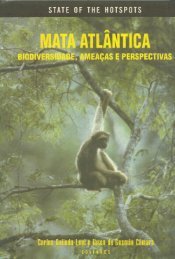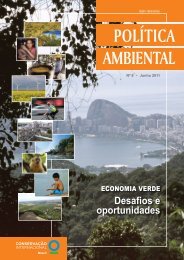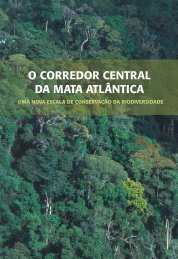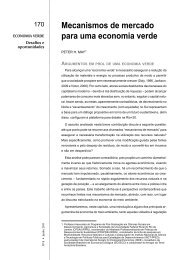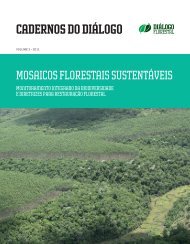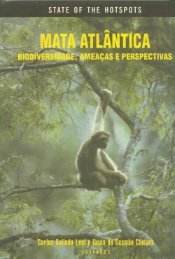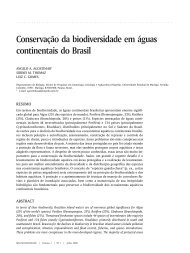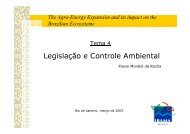Rapid Assessment Program - Conservação Internacional
Rapid Assessment Program - Conservação Internacional
Rapid Assessment Program - Conservação Internacional
Create successful ePaper yourself
Turn your PDF publications into a flip-book with our unique Google optimized e-Paper software.
forcement be effective enough to guarantee that the relocation<br />
will persist?<br />
Any fate other than relocation for Vila Brasil will be<br />
permanently illegal, opening risky precedents for the maintenance<br />
not just of Tumucumaque, but for other conservation<br />
units in Amapá as well. One possibility is the exclusion of<br />
Vila Brasil from the park’s limits, supported by a specific redesign<br />
of that part of the park. This is very controversial at<br />
first glance but, based on the size of the Park, is a possibility<br />
to be considered since it would not significantly affect the<br />
Park’s integrity.<br />
Contrary to other parks in Brazil, Tumucumaque has<br />
the privilege of having its land status legally recognized, has<br />
no conflict involving human populations, has a management<br />
team officially responsible for it, and has financial resources<br />
available for infrastructure, maintenance, research, enforcement<br />
and monitoring. Such an uncommon scenario seems<br />
to indicate very good medium-term perspectives. However,<br />
unfortunately, the park creation process was not smooth,<br />
and some members of the Amapá society still harbor resentment.<br />
A short-term challenge is to promote the concept of<br />
a national park among the local society. Therefore, we suggest<br />
a strengthening of communication between the Park<br />
and Amapá society, through campaigns visiting the schools<br />
and universities in Macapá and in the cities surrounding the<br />
park. Such campaigns should be designed for students and<br />
stakeholders focusing on: 1) the importance and rewards<br />
that a national park can produce; 2) the legal steps that have<br />
to be concluded in order to allow visitors in the park; and<br />
3) the current status of this process and expectations about<br />
its conclusion. We also suggest a study be conducted to examine<br />
the local community’s perception towards the park.<br />
Such a study should precisely identify who and where are the<br />
stakeholders contrary or favorable to the park, allowing the<br />
establishment of specific strategies to approach such people.<br />
Serra do Navio is currently the place with the easiest<br />
access to the park, based both on the distance to Macapá<br />
and on the existence of infrastructure, including IBAMA’s<br />
office. Even so, we detected the necessity of a stronger institutional<br />
presence of IBAMA in the area, clearly delivering<br />
the message that there is a functional office in the town.<br />
We understand, however, that this would be possible only<br />
after solving one of the Park’s main problems: the size of the<br />
Park’s technical staff is unrealistic considering the amount of<br />
area this staff is responsible for maintaining. The under-staffing<br />
and the fact that a portion of the staff hold permanent<br />
positions in Macapá make it difficult to maintain long-term<br />
activities of surveillance, monitoring, research and communication<br />
necessary to the Park. It is desirable that part of the<br />
staff remains full-time in Serra do Navio and the opening of<br />
an office in November 2006 will increase such demand.<br />
During Expedition I, along the river from Serra do<br />
Navio to the sampling point, we observed the presence of<br />
several abandoned bush camps, some recently so, indicating<br />
the presence of hunters, fishers and vine collectors inside the<br />
Park. Nobody was seen in the Park during our expedition,<br />
Inventários Biológicos Rápidos no Parque Nacional Montanhas do Tumucumaque, Amapá, Brasil<br />
<strong>Rapid</strong> Biological Inventories in the Tumucumaque Mountains National Park, Amapá, Brazil<br />
Sumário das Expedições<br />
but reports from the boat pilots conducting us confirmed the<br />
easy access to that area. It is very likely that the encroachers<br />
were aware of the expedition and left the area before us. The<br />
access through the Amapari River is a strategic site for surveillance<br />
and access control to the Park, therefore we suggest the<br />
construction of a surveillance post at this place. Due to the<br />
clear signs of hunting, fishing and collecting in the park, is<br />
highly recommended to undertake studies to assess the impact<br />
of such activities on the local biodiversity. At the same time, we<br />
suggest the intensification of the surveillance in order to reduce<br />
such activities.<br />
There are signs and clues of illegal mining in the park<br />
obtained, for example, by the analyses of satellite images<br />
and the detection of illegal airstrips. The park also borders<br />
areas that were historically occupied by illegal gold and other<br />
mining. Indirect effects of such activities, even though outside<br />
the park, were observed. During Expedition II, the water transparency<br />
along the Camopi river, in French Guiana, and at the<br />
meeting with the Oiapoque River, was clearly affected by the<br />
water pumps used in garimpos. The darkish natural color of<br />
the Oiapoque was dyed by the reddish waters coming from the<br />
Camopi and Siquini rivers. We also observed an intense traffic<br />
of boats transporting garimpeiros between Oiapoque City and<br />
Villa Brasil, the establishment of slums serving as temporary<br />
shelter for the garimpeiros near Vila Brasil and the degradation<br />
of parts of the margins along the Oiapoque River. It is well<br />
known that illegal garimpeiros do not have best practices when<br />
using mercury to separate the gold extracted in Amazonia and<br />
it would be really surprising if the level of mercury contamination<br />
of Siquini and Camopi has not already exceeded the<br />
maximum acceptable levels. Besides all the direct effects of illegal<br />
gold mining, there are several indirect effects that can also<br />
be reported, such as hunting, fishing and logging, plus all the<br />
social problems associated with this activity in Amazonia. The<br />
fight against the opening of illegal airstrips in the Park is laborious,<br />
expensive and time-consuming and requires the support<br />
from the Brazilian Army, Air Force and Federal Police, but,<br />
even so, it must be considered a priority for the Park.<br />
Among the team that joined us during Expedition I were<br />
several boat pilots that know the area very well, frequently visiting<br />
it since the 1960s, when they used to hunt large cats for<br />
skins. Currently, this seems not to occur anymore. Based on<br />
the knowledge these people have of the area and on the day-byday<br />
experience they have in forests habitats, and because they<br />
all live in Serra do Navio, we suggest that, when opened to<br />
visitors, the Park should train these individuals as guides. This<br />
could be a way to strengthen the relationship between the Park<br />
and the local society. A team of well-trained local guides may<br />
also help in monitoring and surveillance, reporting sights of<br />
new animals, monitoring population sizes and migratory species,<br />
or even informing IBAMA about illegal activities. From<br />
the guides’ perspectives, this could be a way to generate income<br />
and to be engaged with the Park’s mission.<br />
The cost and effort to reach some of the sampled areas was<br />
nearly prohibitive and they were visited just because there was<br />
a clear scientific purpose and financial resources available to<br />
reach them. It is very likely that there will be no similar effort<br />
2


